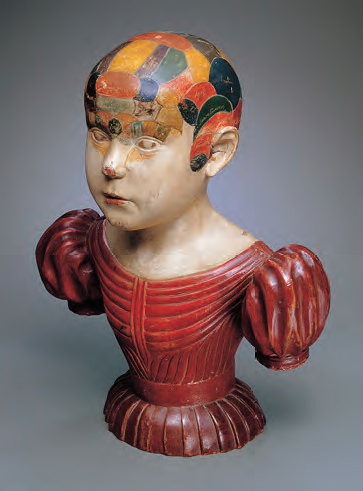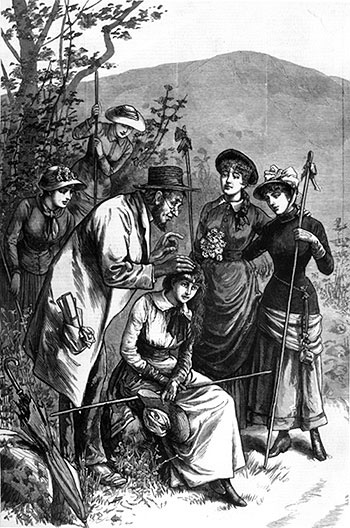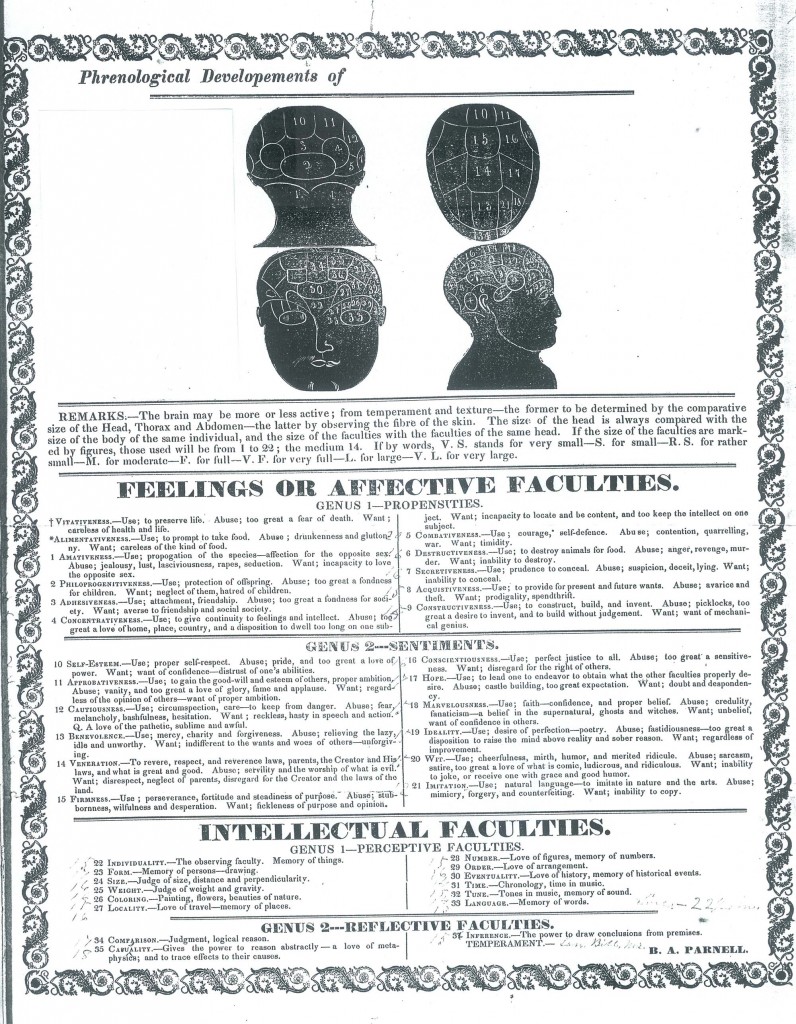Phrenology and Ghosts in Manchester, Part Two of Two
BY RAY BERG AND ALAN DYER
Have you read part 1? Click HERE to read part 1!
Parnell’s Head
As he requested, Dr. Parnell’s head was removed, preserved and shipped to Fowler & Wells in New York City. The brothers Lorenzo Niles Fowler (1811-1896) and Orson Squire Fowler (1809-1887) were two of the leading phrenologists of their time. But their success lay more in commercialization and entrepreneurial activities than in advancing the scientific theories of phrenology. Orson, together with his associate Samuel Wells, started the Fowler & Wells phrenological business and publishing house in 1838. Orson Fowler is also well known for his promotion of octagonal homes and the presumed therapeutic power they contained. Lorenzo spent much of his life in England where he developed the phrenology head (a china head showing the location of a person’s phrenological faculties). It soon became a symbol of the discipline. Many Victorian homes displayed such heads as evidence of an educated and liberal-minded family.
Figure 4 – Victorian-Era Phrenological Bust, Typically Kept in Homes for Reference
Figure 5 – The Traveling Phrenologist, as Portrayed by Joseph Becker in a 19th Century Newspaper
Fowler & Wells also maintained an extensive collection of papers and a museum of phrenological specimens (preserved heads, crania, skulls, etc.) in New York City. Among this collection, a sketch of Dr. Parnell was recorded as being in the archives. The museum operated until its closure in 1911, and most likely was the final resting place of Dr. Parnell’s preserved head until the final bankruptcy of Fowler & Wells occurred in 1914. The authors contacted the New York Public Library for any records concerning the disposition of the archives and museum contents after the bankruptcy, both to track down the Parnell sketch, and, out of perhaps morbid curiosity, what had become of Parnell’s head.
The family business papers were located in archives at Cornell University, where Parnell’s sketch may still exist. There is no specific mention of the museum artifacts at Cornell, but a 1971 publication entitled Heads and Headlines: The Phrenological Fowlers, by Madeleine B. Sterns, states that Charlotte Fowler Wells, both a sister of the Fowler brothers and the wife of Samuel Wells, maintained a cabinet collection of busts, crania and portraits assembled by Fowler & Wells through the years, and was seeking an $18,000 donation around 1910 to construct the necessary museum for housing these artifacts at Cornell. The required funding could not be raised due to the growing dismissal of phrenology as a valid science by this time, and the collection of busts, crania and other materials were dispersed or destroyed. An 1875 catalogue of the Fowler & Wells collection of physical busts, preserved heads, etc. is also listed as being at Yale University’s Library, but contact with Yale indicated this book as “missing” from the shelves.
Now for the Ghost….
Dr. Parnell came back to haunt Manchester in an unexpected way some 53 years after his passing. On May 24, 1900, Mat Blosser reported in the Manchester Enterprise a story entitled “Now Wants His Head”. After a fairly inaccurate summary of Dr. Parnell’s background, Blosser related the burial story as we have described it above, and then stated:
…“One of our citizens who is troubled somewhat with insomnia, informed the ENTERPRISE that he often wanders over there to the old grave yard in the gray of the morning, before the glorious orb of the day has gilded the clouds or the birds begun their songs of praise. He told us how he once sat down on the little mound [Parnell’s grave], and must have fallen asleep. Finally he heard a voice saying, “I want my head”, and asking who made the demand was told that it was Parnell. “Well”, replied our friend, “I haven’t got your head.” “But you’re a citizen of this place, aren’t you?” “Yes.” “Well, fifty years ago they cut off my head, and now I want it back.” “I don’t know anything about that”, our friend replied, “but say, if you have gotten along all this time without a head, I don’t see why you should be in such a hurry for it now.” About this time our friend awoke…”
Blosser often editorialized about the sad state of the original burying ground during his ownership of the paper, demanding the Village and its residents remove and rebury the remaining bodies in Oak Grove Cemetery, and thus continued his preaching:
“The old burying ground is also the resting place of some of our earliest residents. A few marble slabs, and an occasional board once painted white, can be found hidden in the tall grass or tangle of brush and vines. The grounds might be made a pleasant spot, but they have been abandoned. If something is not done before long, there may be a rattling among the dry bones over there and more of our citizens be disturbed by “Low from the grave a doleful sound”.
As of 2014, Dr. B. A. Parnell is still there on top of the hill, and Manchester’s original cemetery remains unmarked.
Phrenology still exists as a “science” under study by several individuals and organizations. See www.Phrenology.org. As proof of its practice today, in 2007 the State of Michigan included “phrenology services” among those businesses to be subject to a 6% service tax. We guess the State still believes in probing the skulls of its taxpayers for useful information.
Figure 6 – Dr. Parnell’s Broadside, Printed in Ann Arbor, 1830s











You must be logged in to post a comment Login